
This week’s puzzle is a crossword puzzle testing your knowledge of Tudor weather.
How much do you know about weather events in the Tudor period?
Find out with this fun crossword puzzle.
[Read More...]
This week’s puzzle is a crossword puzzle testing your knowledge of Tudor weather.
How much do you know about weather events in the Tudor period?
Find out with this fun crossword puzzle.
[Read More...]
On this day in Tudor history, 17 April 1554, in the reign of Queen Mary I, celebrations for the acquittal of a Tudor courtier led to the head of his fellow rebel being stolen. It was the head of Sir Thomas Wyatt the Younger.
Find out what happened
[Read More...]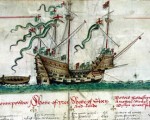
On this day in Tudor history, in the reign of King Henry VIII, a ship that would become the king’s favourite flagship began her first tour of duty.
Find out more about The Mary Rose’s career in this video…
[Read More...]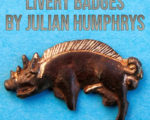
This Friday’s video is a fascinating look into livery badges and a special focus on the white boar badge that was used by Richard III’s household and followers and which was found at the site of the Bosworth battle.
[Read More...]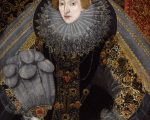
On this day in Tudor history, courtier Sir John Scudamore was laid to rest. His wife served Queen Elizabeth I and appears to have suffered in doing so.
Find out what happened to Mary Scudamore in this #TudorHistoryShorts video:
[Read More...]
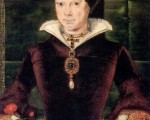
On this day in Tudor history, 14th April 1556, in the reign of Queen Mary I, Sir Anthony Kingston, died at Cirencester. He was on his way to London to face charges that had been laid against him, and it’s likely that he would have been executed.
Why? What had he done?
[Read More...]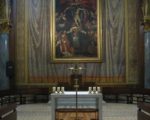
Polydore Plasden was born in 1563 and was the son of a London horner. He was educated at Rheims and then at the English College in Rome. He was ordained as a priest on 7th December 1586. He remained in Rome for a year after his ordination and then moved back to Rheims, where he stayed from 8th April to 2nd September 1588.
When Polydore returned to England in 1588, he ministered in Sussex and London until 1591, at which point he was captured on 2nd November. He was captured in London at Swithun Wells’ house, where Edmund Gennings was celebrating Mass alongside other fellow Catholics who were captured beside Polydore.
[Read More...]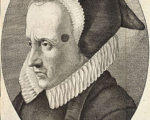
On this day in Tudor history, 13th April 1630, Anne Howard (née Dacre), Countess of Arundel, died at Shifnal.
Anne was the eldest daughter of Thomas Dacre, 4th Lord Dacre of Gilsand, and wife of Philip Howard, 13th Earl of Arundel, but there are some other interesting facts about this Tudor lady.
Find out more about this Countess of Arundel…
[Read More...]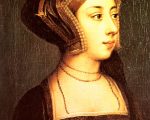
I’ve gone back to doing “on this day” videos as I know people enjoy daily videos. The new ones, however, are YouTube Shorts, so under a minute long, just to give key interesting facts. If I’ve done a longer video in the past then I will share those too. Doing these shorts just gives me more time to create longer videos on Tudor topics.
On this day in Tudor history, 12th April 1533, Anne Boleyn’s behaviour caused a stir and Eustace Chapuys, the imperial ambassador, was outraged. He didn’t know she was actually queen. In his eyes, there was one queen: Catherine of Aragon.
[Read More...]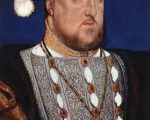
As April is the anniversary of Henry VIII’s accession in 1509, following the death of his father, Henry VII, I thought I’d test your knowledge of Henry VIII with a quiz.
How much do you know about this iconic Tudor king?
Get those little grey cells working with this fun quiz.
[Read More...]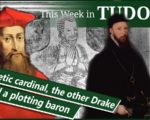
In part two of This Week in Tudor History for the week beginning 5th April, I talk about why Pope Paul IV branded Cardinal Pole a heretic and took away his legatine powers, before introducing you to a sea captain named Drake, but not Sir Francis Drake, and telling you about John Lumley, a baron who was involved with the Ridolfi Plot but kept his head, and a man who was recorded as owning a full-length portrait of Anne Boleyn.
[Read More...]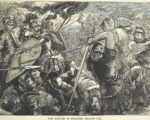
“I have a fascination to learn by whom, how and to what extent the battlefields of Bosworth, Flodden, Stoke Field and others were cleared in the aftermath. What happened to what was left – carnage, the armour, horses, weapons, personal effects and of course the bodies?”
Our military historian Julian Humphrys of the Battlefields Trust has answered the question. A big thank you to him!
In general terms it was very much a case of ‘to the victor, the spoils’ with the army left in possession of the field at the end of a battle having the pick of whatever remained there. Indeed, battles of the Medieval and Tudor periods were frequently followed by an intense period of clearing up with everything of potential value being taken by the winners. There was nothing particularly new in this – the lower section of the Bayeux Tapestry shows little men gathering up swords and stripping the dead of armour while the fighting rages above them.
[Read More...]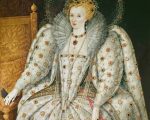
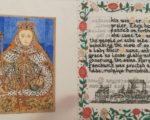
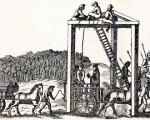
Richard Leigh was born in 1557, the son of Richard Leigh and Clemence Holcroft, daughter of Sir John Holcroft.
Leigh was the subject of an arranged marriage in 1562 with Anne Belfield, daughter of Ralph Belfield of Clegg Hall. Anne’s sister, Elizabeth, was also married that day to Alexander Barlow. However, both marriages were annulled at a later date on the grounds that they were all too young to be legally married.
[Read More...]
In part 1 of This Week in Tudor History for the week beginning 5th April, I will be talking about King James VI of Scotland’s journey from Edinburgh to London, following his accession to the throne of England as James I; the life and career of Henry Stafford, Earl of Wiltshire, who managed to avoid the awful fates of his father and brother despite his Plantagenet blood; the death of King Charles VIII of France after hitting his head on a lintel, and the accession of King Louis XII, and finally Magdalen Browne, Viscountess Montagu, patron of Catholics and a woman whose properties were Catholic safe houses in Elizabeth I’s reign.
[Read More...]

Today is Easter Sunday so it seems apt to celebrate with a fun Holy Week and Easter Word Search. Happy Easter!
Simply click on the image or link below to open and print out.
Remember, the words can go in any direction!
[Read More...]
Today, in the Western Christian Church, is Good Friday, which, of course, commemorates the crucifixion of Jesus Christ. I’m going to mark the dat by sharing how the day was commemorated in Tudor times.
But first, here is the account of Christ’s crucifixion from John’s Gospel. I’ve chosen the 16th century Tyndale Bible:
[Read More...]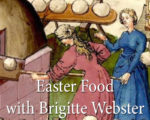
This week’s Friday video is hosted by Brigitte Webster and is all about the wonderful feasting and food of Easter. After a period of abstinence during Lent, what did the Tudors actually enjoy eating?
[Read More...]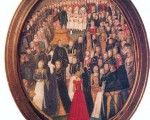
Maundy Thursday commemorates the Last Supper, that final meal that Jesus Christ had with his disciples before his arrest.
In Tudor times, on Maundy Thursday, the church was prepared for Easter with water and wine being used to wash the altars and it was traditional for people to go to confession. The three holy oils – the chrism oil, the oil of catechumens and the oil of the sick – were also blessed on this day.
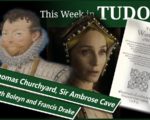
In this second part of This Week in Tudor history, which covers 1st to 4th April, historian and author Claire Ridgway talks about Thomas Churchyard, a poet and soldier who kept being imprisoned; Sir Ambrose Cave, a man who joined the Order of St John as early as he possibly could, but survived its dissolution and ended his days serving Elizabeth I; before moving on to the death of Elizabeth Boleyn, Countess of Wiltshire, mother of Queen Anne Boleyn and grandmother of Queen Elizabeth I, and finishing with the knighting of explorer Francis Drake.
[Read More...]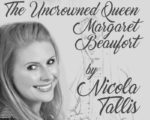
Our April expert speaker is historian Nicola Tallis, author of Crown of Blood and Elizabeth’s Rival. Her latest book, Uncrowned Queen, is on Lady Margaret Beaufort, the matriarch of the Tudor dynasty, and Margaret is the subject of Nicola’s talk for us.
[Read More...]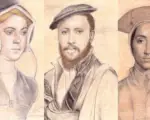

What an informative chat we had with Phil Downing. The subject of priest holes, or hides, is such an alien one for us living today, yet for a period of time, they were literally a matter of life and death for some people.
[Read More...]
In this first part of This Week in Tudor History for week beginning 29th March, I talk about William Wager, a playwright and clergyman who picked wonderful titles for his works; the interesting life and career of Sir Ralph Sadler, who started out working for Thomas Cromwell and who went on to serve Henry VIII, Edward VI, Queen Jane (Lady Jane Grey) and Elizabeth I – oh, and I will tell you about his bigamous marriage! Then, finally, I will leave you with the dying King Henry VIII making his last will and testament.
[Read More...]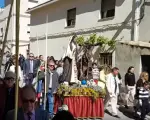
Today, Palm Sunday, is the first day of Holy Week, a day which commemorates the entry of Jesus into Jerusalem on the back of a donkey, as told in the Gospels:
“On the next day much people that were come to the feast, when they heard that Jesus was coming to Jerusalem, took branches of palm trees, and went forth to meet him, and cried, ‘Hosanna: Blessed is the King of Israel that cometh in the name of the Lord.’ And Jesus, when he had found a young ass, sat thereon; as it is written, ‘Fear not, daughter of Sion: behold, thy King cometh, sitting on an ass’s colt’.”
[Read More...]
As we’re very nearly at the end of March, I though I’d test your knowledge of Tudor people who were either born or died in March. These are all people who have been mentioned in posts and videos on the Tudor Society website, but how much can you remember about them?
Test yourself with this fun puzzle.
[Read More...]